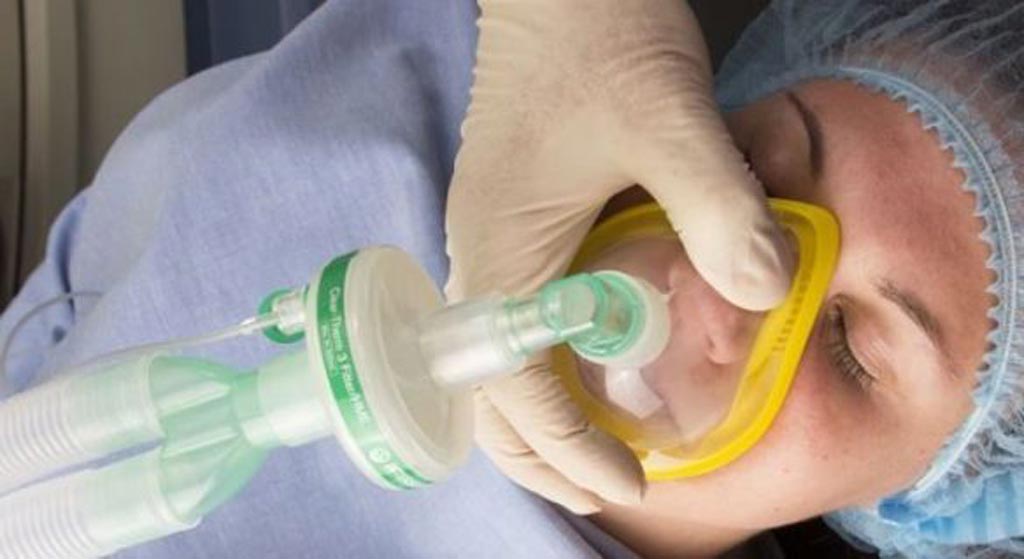Front Line COVID-19 Critical Care Consortium Recommends Early Delivery of Anti-Inflammatory Therapies
|
By HospiMedica International staff writers Posted on 04 May 2020 |

Illustration
A group of five critical care specialists have jointly released a protocol for treating COVID-19 patients who are brought to hospitals, urging the immediate adoption of early intervention protocol to prevent mortality and reduce the need for ventilators.
The five leading critical care specialists, who together have formed the Front Line COVID-19 Critical Care Consortium, have released a protocol for treating patients who arrive in hospitals with COVID-19. Based on available research, the experience in China reflected by the Shanghai expert commission, and their decades-long professional experiences in Intensive Care Units (ICUs) around the country, the experts have strongly urged fellow physicians to immediately adopt a change in strategy by delivering powerful therapies earlier in the disease course, prior to admission to the ICU or the need for a mechanical ventilator. Based on early experiences with this more aggressive approach, they predict that early adoption of the protocol will reduce ICU admissions, obviate the need for mechanical ventilators, and most importantly, save many lives.
According to Dr. Pierre Kory, the Medical Director of the Trauma and Life Support Center and Chief of the Critical Care Service at the University of Wisconsin, it is the severe inflammation sparked by the coronavirus, not the virus itself that kills patients. Inflammation causes a new variety of Acute Respiratory Distress Syndrome (ARDS), which damages the lungs. The typical treatment for ARDS is to put patients on a mechanical ventilator, but Dr. Paul E. Marik, of the Eastern Virginia Medical School, says that should be the very last resort. The experts have emphasized that early intervention is critical in preventing the deterioration and death that has been described across the world once patients enter the ICU. By changing the therapeutic strategy towards initiating the combination of high-dose ascorbic acid and corticosteroids earlier in the disease course, the need for mechanical ventilation can be greatly reduced.
The critical care specialists have advised that in all COVID-19 hospitalized patients, the therapeutic focus must be placed on early intervention utilizing powerful, evidence-based therapies to counteract the overwhelming and damaging inflammatory response and the systemic and severe hyper-coagulable state causing organ damage By initiating the protocol within six hours of presentation in the emergency room, the need for mechanical ventilators and ICU beds will decrease dramatically, according to the experts.
“It is imperative that every hospital immediately adopt this safe, low-cost and highly effective treatment protocol, but they must implement it BEFORE the ICU, not after they reach the ICU because, in this disease, the organ damage tends to be so severe that patients rarely recover at that point,” said New York internist, Dr. Keith Berkowitz.
“This protocol will not only save patients’ lives, it will also lessen the danger to the doctors and nurses who treat them by decreasing the need for mechanical ventilators,” added Dr. Howard Kornfeld, President of the Pharmacology Policy Institute.
The five leading critical care specialists, who together have formed the Front Line COVID-19 Critical Care Consortium, have released a protocol for treating patients who arrive in hospitals with COVID-19. Based on available research, the experience in China reflected by the Shanghai expert commission, and their decades-long professional experiences in Intensive Care Units (ICUs) around the country, the experts have strongly urged fellow physicians to immediately adopt a change in strategy by delivering powerful therapies earlier in the disease course, prior to admission to the ICU or the need for a mechanical ventilator. Based on early experiences with this more aggressive approach, they predict that early adoption of the protocol will reduce ICU admissions, obviate the need for mechanical ventilators, and most importantly, save many lives.
According to Dr. Pierre Kory, the Medical Director of the Trauma and Life Support Center and Chief of the Critical Care Service at the University of Wisconsin, it is the severe inflammation sparked by the coronavirus, not the virus itself that kills patients. Inflammation causes a new variety of Acute Respiratory Distress Syndrome (ARDS), which damages the lungs. The typical treatment for ARDS is to put patients on a mechanical ventilator, but Dr. Paul E. Marik, of the Eastern Virginia Medical School, says that should be the very last resort. The experts have emphasized that early intervention is critical in preventing the deterioration and death that has been described across the world once patients enter the ICU. By changing the therapeutic strategy towards initiating the combination of high-dose ascorbic acid and corticosteroids earlier in the disease course, the need for mechanical ventilation can be greatly reduced.
The critical care specialists have advised that in all COVID-19 hospitalized patients, the therapeutic focus must be placed on early intervention utilizing powerful, evidence-based therapies to counteract the overwhelming and damaging inflammatory response and the systemic and severe hyper-coagulable state causing organ damage By initiating the protocol within six hours of presentation in the emergency room, the need for mechanical ventilators and ICU beds will decrease dramatically, according to the experts.
“It is imperative that every hospital immediately adopt this safe, low-cost and highly effective treatment protocol, but they must implement it BEFORE the ICU, not after they reach the ICU because, in this disease, the organ damage tends to be so severe that patients rarely recover at that point,” said New York internist, Dr. Keith Berkowitz.
“This protocol will not only save patients’ lives, it will also lessen the danger to the doctors and nurses who treat them by decreasing the need for mechanical ventilators,” added Dr. Howard Kornfeld, President of the Pharmacology Policy Institute.
Latest COVID-19 News
- Low-Cost System Detects SARS-CoV-2 Virus in Hospital Air Using High-Tech Bubbles
- World's First Inhalable COVID-19 Vaccine Approved in China
- COVID-19 Vaccine Patch Fights SARS-CoV-2 Variants Better than Needles
- Blood Viscosity Testing Can Predict Risk of Death in Hospitalized COVID-19 Patients
- ‘Covid Computer’ Uses AI to Detect COVID-19 from Chest CT Scans
- MRI Lung-Imaging Technique Shows Cause of Long-COVID Symptoms
- Chest CT Scans of COVID-19 Patients Could Help Distinguish Between SARS-CoV-2 Variants
- Specialized MRI Detects Lung Abnormalities in Non-Hospitalized Long COVID Patients
- AI Algorithm Identifies Hospitalized Patients at Highest Risk of Dying From COVID-19
- Sweat Sensor Detects Key Biomarkers That Provide Early Warning of COVID-19 and Flu
- Study Assesses Impact of COVID-19 on Ventilation/Perfusion Scintigraphy
- CT Imaging Study Finds Vaccination Reduces Risk of COVID-19 Associated Pulmonary Embolism
- Third Day in Hospital a ‘Tipping Point’ in Severity of COVID-19 Pneumonia
- Longer Interval Between COVID-19 Vaccines Generates Up to Nine Times as Many Antibodies
- AI Model for Monitoring COVID-19 Predicts Mortality Within First 30 Days of Admission
- AI Predicts COVID Prognosis at Near-Expert Level Based Off CT Scans
Channels
Critical Care
view channel
CPR Guidelines Updated for Pediatric and Neonatal Emergency Care and Resuscitation
Cardiac arrest in infants and children remains a leading cause of pediatric emergencies, with more than 7,000 out-of-hospital and 20,000 in-hospital cardiac arrests occurring annually in the United States.... Read more
Ingestible Capsule Monitors Intestinal Inflammation
Acute mesenteric ischemia—a life-threatening condition caused by blocked blood flow to the intestines—remains difficult to diagnose early because its symptoms often mimic common digestive problems.... Read more
Wireless Implantable Sensor Enables Continuous Endoleak Monitoring
Endovascular aneurysm repair (EVAR) is a life-saving, minimally invasive treatment for abdominal aortic aneurysms—balloon-like bulges in the aorta that can rupture with fatal consequences.... Read more
Wearable Patch for Early Skin Cancer Detection to Reduce Unnecessary Biopsies
Skin cancer remains one of the most dangerous and common cancers worldwide, with early detection crucial for improving survival rates. Traditional diagnostic methods—visual inspections, imaging, and biopsies—can... Read moreSurgical Techniques
view channel
Robotic Assistant Delivers Ultra-Precision Injections with Rapid Setup Times
Age-related macular degeneration (AMD) is a leading cause of blindness worldwide, affecting nearly 200 million people, a figure expected to rise to 280 million by 2040. Current treatment involves doctors... Read more
Minimally Invasive Endoscopic Surgery Improves Severe Stroke Outcomes
Intracerebral hemorrhage, a type of stroke caused by bleeding deep within the brain, remains one of the most challenging neurological emergencies to treat. Accounting for about 15% of all strokes, it carries... Read morePatient Care
view channel
Revolutionary Automatic IV-Line Flushing Device to Enhance Infusion Care
More than 80% of in-hospital patients receive intravenous (IV) therapy. Every dose of IV medicine delivered in a small volume (<250 mL) infusion bag should be followed by subsequent flushing to ensure... Read more
VR Training Tool Combats Contamination of Portable Medical Equipment
Healthcare-associated infections (HAIs) impact one in every 31 patients, cause nearly 100,000 deaths each year, and cost USD 28.4 billion in direct medical expenses. Notably, up to 75% of these infections... Read more
Portable Biosensor Platform to Reduce Hospital-Acquired Infections
Approximately 4 million patients in the European Union acquire healthcare-associated infections (HAIs) or nosocomial infections each year, with around 37,000 deaths directly resulting from these infections,... Read moreFirst-Of-Its-Kind Portable Germicidal Light Technology Disinfects High-Touch Clinical Surfaces in Seconds
Reducing healthcare-acquired infections (HAIs) remains a pressing issue within global healthcare systems. In the United States alone, 1.7 million patients contract HAIs annually, leading to approximately... Read moreHealth IT
view channel
Printable Molecule-Selective Nanoparticles Enable Mass Production of Wearable Biosensors
The future of medicine is likely to focus on the personalization of healthcare—understanding exactly what an individual requires and delivering the appropriate combination of nutrients, metabolites, and... Read moreBusiness
view channel
Philips and Masimo Partner to Advance Patient Monitoring Measurement Technologies
Royal Philips (Amsterdam, Netherlands) and Masimo (Irvine, California, USA) have renewed their multi-year strategic collaboration, combining Philips’ expertise in patient monitoring with Masimo’s noninvasive... Read more
B. Braun Acquires Digital Microsurgery Company True Digital Surgery
The high-end microsurgery market in neurosurgery, spine, and ENT is undergoing a significant transformation. Traditional analog microscopes are giving way to digital exoscopes, which provide improved visualization,... Read more
CMEF 2025 to Promote Holistic and High-Quality Development of Medical and Health Industry
The 92nd China International Medical Equipment Fair (CMEF 2025) Autumn Exhibition is scheduled to be held from September 26 to 29 at the China Import and Export Fair Complex (Canton Fair Complex) in Guangzhou.... Read more















